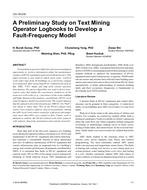-
-
Available Formats
- Options
- Availability
- Priced From ( in USD )
-
Available Formats
-
- Immediate download
- $16.00
- Add to Cart
Customers Who Bought This Also Bought
-

CH-18-014 -- Annual Energy Performance Evaluation of Seri...
Priced From $16.00 -

CH-18-010 -- Improving the Energy Efficiency of a Midsize...
Priced From $16.00 -

CH-18-004 -- Modeling Variable-Airflow Parallel Fan-Power...
Priced From $16.00 -

CH-18-016 -- A Preliminary Study on Text Mining Operator ...
Priced From $16.00
About This Item
Full Description
A heat recovery chiller provides heating hot water tobuildings by using recovered heat from the chiller, which is efficientand cost-effective. However, not every central plant is anappropriate application for heat recovery chillers becausecoincident heating hot-water and chilled-water loads arerequired. Most previous studies on applications of heat recoverychillers have focused on techniques for optimal design ofa utility plant with heat recovery chillers. There are very fewguidelines for operators on how to run a heat recovery chillersystem efficiently at different operating conditions. Factorsinclude electricity demand charges and rate structure, heatinghot-water supply temperature, heating hot-water loop delta-Tdegeneration, chilled-water loop delta-T degeneration, andthe performance of other variable-speed drive chillers in theplant, which all affect operational efficiency. This paper presentsseveral commissioning measures for a heat recoverychiller application at a large district plant in central Texas. Theon-site measured data from the building automation system(BAS) is used to develop a regression model to evaluate thesavings potential for each measure. The current operatingstrategy saves $270,375/year compared to a baseline chillerwithout heat recovery, but the proposed control strategieswould improve the savings to $389,182/year at current utilityprices, or 43.9% more savings than the current control strategy.Although these savings are based on a case-study project,the methodology and control strategies can be applied to optimizeother heat recovery chiller applications.





